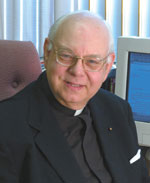Second Sunday of Easter / Msgr. Owen F. Campion
The Sunday Readings
 The Acts of the Apostles supplies this weekend’s first reading. The first several chapters of Acts are fascinating since they so well depict the life of the early Christian community in Jerusalem. This depiction begins with the story of the Lord’s Ascension itself and proceeds forward.
The Acts of the Apostles supplies this weekend’s first reading. The first several chapters of Acts are fascinating since they so well depict the life of the early Christian community in Jerusalem. This depiction begins with the story of the Lord’s Ascension itself and proceeds forward.
Vitally important in the life of the community in Jerusalem was the leadership of the Apostles, with St. Peter as their head. The people held them in great esteem. Such status of the Apostles was not surprising. After all, Jesus had called the Apostles individually, commissioning them to continue the work of salvation after the Ascension.
In this reading, the Apostles work many miracles. When Peter moved among the sick, merely to lie beneath his shadow was enough to be cured of sickness or infirmity. It is a very powerful description of Peter’s place in Christianity.
The implication is clear. Jesus did not leave the Christian body without guidance nor without access to God’s grace. The Acts says that the Apostles, again with Peter as the leader, came together with the community for the “breaking of the bread,” for prayer, for providing aid to the needy, and for healing the sick.
For its second reading, the Church provides a passage from the Book of Revelation. In the reading, John, the author of Revelation, assumed by tradition to have been the Apostle John, tells of being in exile on the island of Patmos in the Aegean Sea. He said that on the Lord’s Day, or Sunday, the day of the Resurrection, he had a vision of Jesus. Jesus ordered John to write about what John saw.
St. John’s Gospel provides the last reading. It begins with an appearance of Jesus before the Apostles. The Lord brings them peace. He then empowers the Apostles to forgive sins. Jesus says that if they forgive, sins are forgiven.
Next comes the familiar story of the doubting Thomas. Other Apostles had seen the Risen Lord, but Thomas had not seen Jesus. Thomas insisted that he would not believe until he personally could touch the wounds of Christ.
When Jesus appeared before the Apostles, Thomas saw the wounds. He proclaimed Jesus as “my Lord and my God!” (Jn 20:28).
The reading ends by stating that Jesus performed many other miracles. The crucified Lord lived.
Reflection
Only a week ago, in celebrating the feast of Easter, the Church joyfully and excitedly proclaimed to us its belief that Jesus was risen. He lives! To emphasize the meaning of this pronouncement, the Church gave us the liturgy of the Easter Vigil, the very summit of the Church’s entire year of formal worship.
This weekend, just a week after Easter, the Church hurries to tell us that the Risen Christ is with us still, visibly, tangibly and dynamically.
Christ still is present with us through the Apostles. The Church does not just say that the Apostles came after the Lord. They represented the Lord.
In the second reading, from the Book of Revelation, we are told of John’s extraordinary encounter with the Risen Lord.
John’s Gospel, in the third reading, continues this process of reporting the Lord’s granting to the Apostles the very power of God itself, by giving them the ability to forgive sins. As sins affront God, only God can forgive sins. Yet Jesus conveyed this power to the Apostles.
Thomas is important to the story. He doubted—not an unusual human reaction to the amazing assertion that Christ had risen from the dead. Then Thomas saw Jesus and uncompromisingly believed.
The Church is saying that we today encounter Christ through the Apostles. Through the Apostles the Lord heals and redeems us. It is a clear and direct self-testimony of the Church’s own sense of its identity. †
 The Acts of the Apostles supplies this weekend’s first reading. The first several chapters of Acts are fascinating since they so well depict the life of the early Christian community in Jerusalem. This depiction begins with the story of the Lord’s Ascension itself and proceeds forward.
The Acts of the Apostles supplies this weekend’s first reading. The first several chapters of Acts are fascinating since they so well depict the life of the early Christian community in Jerusalem. This depiction begins with the story of the Lord’s Ascension itself and proceeds forward.